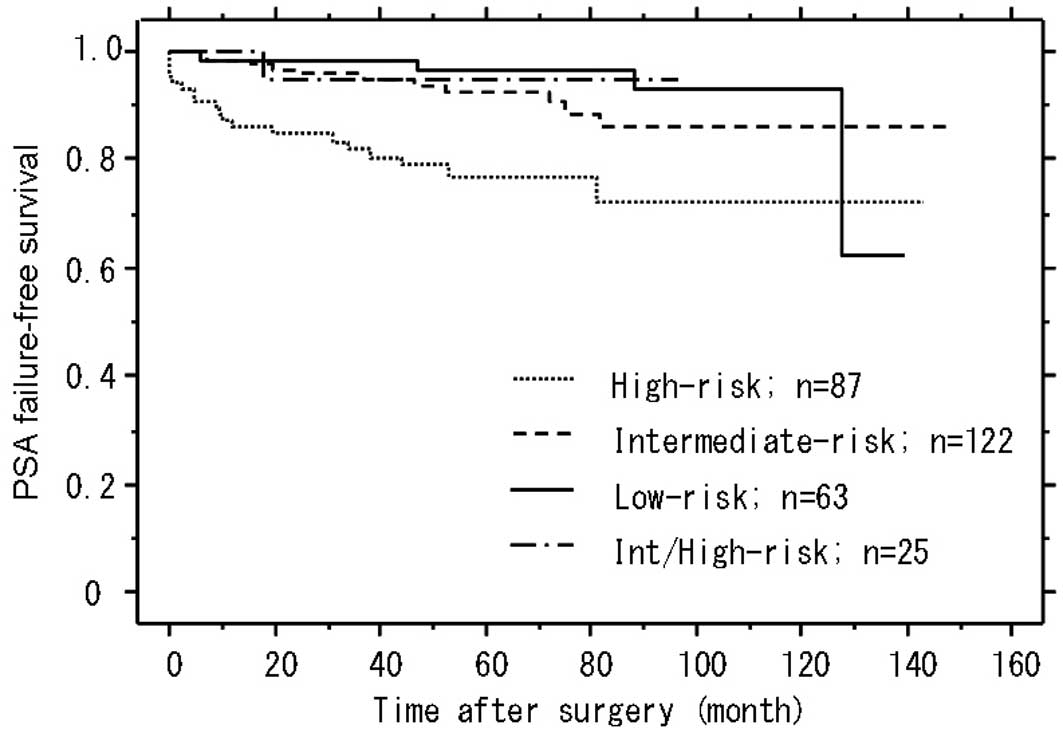Radical prostatectomy as radical cure of prostate cancer in a high‑risk group: A single-institution experience
- Authors:
- Nobuki Furubayashi
- Motonobu Nakamura
- Ken Hishikawa
- Atsushi Fukuda
- Takashi Matsumoto
- Kenichi Nishiyama
- Takeharu Yamanaka
- Yoshihiro Hasegawa
-
View Affiliations
Affiliations: Department of Urology, National Kyushu Cancer Center, Fukuoka, Japan, Department of Pathology, National Kyushu Cancer Center, Fukuoka, Japan, Institute for Clinical Research, National Kyushu Cancer Center, Fukuoka, Japan
- Published online on: November 15, 2012 https://doi.org/10.3892/mco.2012.39
-
Pages:
337-342
Abstract
This study aimed to evaluate the possibility of performing radical prostatectomy (RP) alone to achieve radical cure of prostate cancer in a high‑risk group. Between August 1998 and December 2008, 436 Japanese patients underwent antegrade RP following the exclusion of 139 patients. According to the D'Amico criteria, the low-, intermediate- and high‑risk groups comprised 63, 122 and 112 patients, respectively. Twenty-five patients who were classified into the high‑risk group based only on T2c stage, were evaluated as a separate intermediate/high‑risk group. Results of the multivariate analysis revealed that of the preoperative characteristics only a biopsy Gleason score was a significant predictor in patients with and without PSA failure (P=0.017). After a median follow‑up period of 60 months, the PSA failure‑free rates in the low-, intermediate-, high‑ and intermediate/high‑risk groups were 96.5, 92.2, 76.8 and 95.0%, respectively. No statistically significant difference was detected in the high‑ and intermediate/high‑risk groups (P=0.064). Thus, patients classified into the high‑risk group based on cT2 stage only, are considered to be potentially eligible for radical treatment by surgery alone, and should not be evaluated as high‑risk patients.
View References
|
1
|
D’Amico AV, Whittington R, Malkowicz SB,
et al: Biochemical outcome after radical prostatectomy, external
beam radiation therapy, or interstitial radiation therapy for
clinically localized prostate cancer. JAMA. 280:969–974. 1998.
|
|
2
|
Epstein JI, Allsbrook WC Jr, Amin MB and
Eqevad LL; ISUP Grading Committee: The 2005 International Society
of Urological Pathology (ISUP) Consensus Conference on Gleason
Grading of prostatic carcinoma. Am J Surg Pathol. 29:1228–1242.
2005. View Article : Google Scholar : PubMed/NCBI
|
|
3
|
Sobin LH, Gospodarowicz MK and Wittekind
Ch: TNM Classification of Malignant Tumors. 7th edition.
Wiley-Blackwell; Oxford: 2009
|
|
4
|
Grossfeld GD, Latini DM, Lubeck DP,
Broering JM, Li YP, Mehta SS and Carroll PR: Predicting disease
recurrence in intermediate and high-risk patients undergoing
radical prostatectomy using percent positive biopsies: results from
CaPSURE. Urology. 59:560–565. 2002. View Article : Google Scholar
|
|
5
|
D’Amico AV, Whittington R, Malkowicz SB,
et al: Predicting prostate specific antigen outcome preoperatively
in the prostate specific antigen era. J Urol. 166:2185–2188.
2001.PubMed/NCBI
|
|
6
|
Manoharan M, Bird VG, Kim SS, Civantos F
and Soloway MS: Outcome after radical prostatectomy with a
pretreatment prostate biopsy Gleason score of >/=8. BJU Int.
92:539–544. 2003.
|
|
7
|
Boorjian SA, Kames RJ, Crispen PL, Ragel
LJ, Berqstralh EJ, Sebo TJ and Blute ML: The impact of discordance
between biopsy and pathological Gleason scores on survival after
radical prostatectomy. J Urol. 181:95–104. 2009. View Article : Google Scholar : PubMed/NCBI
|
|
8
|
Kawamorita N, Saito S, Ishidoya S, Ito A,
Saito H, Kato M and Arai Y: Radical prostatectomy for high-risk
prostate cancer: biochemical outcome. Int J Urol. 16:733–738. 2009.
View Article : Google Scholar : PubMed/NCBI
|
|
9
|
Mian BM, Troncoso P, Okihara K, Bhadkamkar
V, Johnston D, Reves AO and Babaian RJ: Outcome of patients with
Gleason score 8 or higher prostate cancer following radical
prostatectomy alone. J Urol. 167:1675–1680. 2002. View Article : Google Scholar : PubMed/NCBI
|
|
10
|
Byar DP and Mostofi FK: Carcinoma of the
prostate: prognostic evaluation of certain pathologic features in
208 radical prostatectomies. Examined by the step-section
technique. Cancer. 30:5–13. 1972. View Article : Google Scholar
|
|
11
|
Cooperberg MR, Cowan J, Broering JM and
Carroll PR: High-risk prostate cancer in the United States,
1990–2007. World J Urol. 26:211–218. 2008.
|














